Press Release
|
|
|
|
|
|

Imagine a little-known national treasure — a largely wild land home to ocelots, exotic and imperiled birds like elegant trogons and Mexican spotted owls, imperiled reptiles and amphibians like the threatened Chiricuahua leopard frog, and El Jefe, the only jaguar currently living in the United States. This is the Mountain Empire of southern Arizona, a place as special as Yosemite or Yellowstone, and worthy of international recognition. Extending across the border into northern Sonora, Mexico, this region is bounded by mountains that rise from the flat desert floor to touch the sky. With one of the richest concentrations of biodiversity in the U.S., the Mountain Empire is a sanctuary for imperiled species. But even a sanctuary can be threatened.

Mountain Empire, © Thunderforest
One reason the Mountain Empire has so many rare and unique species is the rugged sky island mountain ranges. Each range, like the iconic Santa Rita Mountains, south of Tucson, stands alone surrounded by desert flatlands like an island in the sea, with mountains so tall that they span climate zones from hot, dry desert to moist forests at higher altitudes. Together, these characteristics give the mountains their nicknames of “sky islands.” For many species, the sky islands are refuges where human impacts have been relatively small. Streams rise from the rocks, nurturing rare fish, frogs, snakes, and nesting habitat for birds like threatened yellow-billed cuckoos, southwestern willow fly catchers and hummingbirds.
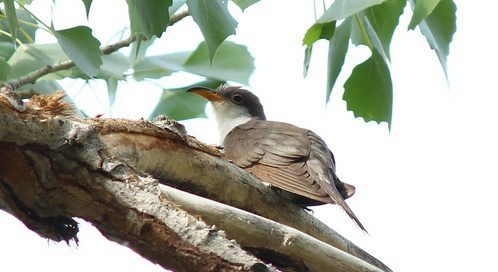
Western yellow-billed cuckoo, © Creed Clayton/USFWS
There are so many hummingbird species in the Mountain Empire that the Tucson Audubon Society founded the Paton Hummingbird Center, dedicated to conserving hummingbirds and other local biodiversity.
Birders visit from countries around the world for the chance to see so many species in one place. One of Defenders’ board members, Dr. Ron Pulliam, works with the Mountain Empire group Borderlands Restoration to restore the plants that hummingbirds, bees, butterflies, and moths need along Harshaw and Sonoita Creeks in the Patagonia Mountains. The globally imperiled Patagonia eyed silk moth, once widespread in native grasslands, is now making its last U.S. stand in the Patagonia Mountains. The threatened southwestern willow flycatcher, once common near Tucson in now-vanished gallery forest along the Santa Cruz River, is today found higher up in riparian vegetation along still-flowing mountain streams.
One of the gems of the Mountain Empire is the Las Cienegas National Conservation Area: 45,000 acres of rolling grasslands, oak-studded hills, along with the Cienegas Creek wetlands. This is home to the world’s largest population of endangered Gila topminnow and other federally threatened and endangered fish, frogs and snakes. Las Cienegas provides a vital corridor of protected lands that connects the Santa Rita and Whetstone sky islands.
The most revered animal in the Mountain Empire is El Jefe, a powerful male jaguar. Video of him prowling along a stream in the Santa Rita Mountains recently went viral, with at least 20 million viewers. He and other jaguars and ocelots most likely came north to the U.S. from Sonora, Mexico in the past decade, travelling along sky island mountain corridors with little human activity.
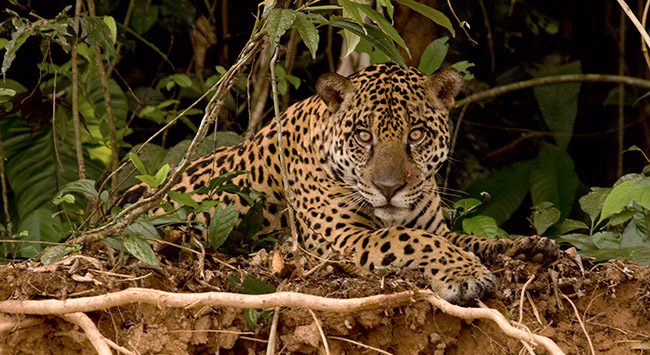
Jaguar, © Barry Draper
Sadly, as much healthy habitat as there is in this region, there’s also a problem: Industrial mining. The Mountain Empire is riddled with old abandoned mines and grandiose plans for new ones. As you can imagine, mining has a massive impact on an ecosystem, from the land itself, to the noise that can scare wildlife away, to the traffic that would come in and out of the mining project. And perhaps most importantly, there’s the water.
Throughout the Southwest, so much groundwater has been pumped for agriculture, industry, and towns and cities that water tables have dropped and streams and ponds have dried up, desiccating wildlife habitat in a land already parched. This is why so many water-dependent species have vanished, or are threatened or endangered. In Arizona, 20 of 35 surviving native fish species are endangered and one is already extinct. Mining presents yet another threat to the water supply, using up billions of gallons of groundwater over the course of years, and often contaminating it with pollutants.
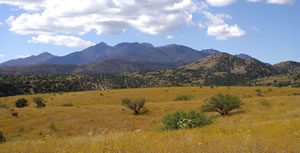
Santa Rita Mts, © Larry Jones/USFS
The diversity of the “sacred” Santa Rita Mountains in the Coronado National Forest is threatened by mining interests.
The giant open-pit Rosemont Mine is planned for the Mountain Empire’s Santa Rita Mountains, where it would destroy habitat that is home to El Jefe and endangered ocelots. It would also decrease the water for the topminnow and other species in the Las Cienegas wetlands.
Two other mines are planned for the Patagonia Mountains in the center of the Mountain Empire. A Canadian company (ironically called Arizona Mining) is planning the Hermosa mine, which means beautiful in Spanish. There is nothing beautiful about this proposed silver mine: If done by the most economical open-pit method, it would gash a huge 4,000 foot wide hole in the mountains and dump the waste rock on the ground. A recent study by Earthworks and the Patagonia Area Resource Alliance estimated that an open-pit mine here would take as much as 1.2 billion gallons of water per year from nearby streams and wells, harming wildlife as well as the local economy, which is based largely on ranching and tourism. Exploratory drilling (to prove the minerals are worth mining) is already taking place right next to Harshaw Creek, up against the protected activity center for a pair of threatened Mexican spotted owls and habitat for threatened yellow-billed cuckoos.
Thankfully, none of these projects are going unchallenged. Defenders and the Patagonia Area Resource Alliance (PARA) are currently reviewing and preparing formal federal comments on a proposal by Arizona Mining to expand exploratory drilling onto Forest Service land. Last year, Defenders and PARA also joined in a lawsuit that overturned the Forest Service’s illegal approval of plans by another mining company, Regal Resources, to drill exploration cores along Harshaw Creek.
The Mountain Empire is an irreplaceable landscape in the Southwest. Defenders will keep working with local activists to monitor toxic spills and stop illegal mining that would harm the jaguars, ocelots, and other rare species that make it their home.
 Rob Peters, Senior Representative, Southwest Office
Rob Peters, Senior Representative, Southwest Office
As a jack-of-all trades in the Tucson Office, Rob collaborates with the Defenders Renewable Energy Group, helping evaluate and influence renewable energy policies and projects to ensure that renewable energy is developed wisely, with minimum harm to natural ecosystems. He also works on jaguar issues, helping plan for the eventual return of a viable population in the U.S., and he is the lead on Defenders efforts to safeguard Arizona’s Mountain Empire, a Defenders’ priority area surrounding the town of Patagonia. This area contains some of the last best native grasslands in the Southwest, along with important habitat for jaguar, Mexican spotted owl, and other endangered species.
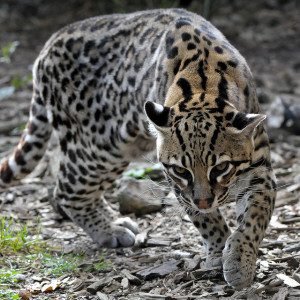
FOR IMMEDIATE RELEASE
Contact: Courtney Sexton, csexton@defenders.org, 202-772-0253
Wendy Russell, wendy@patagoniaalliance.org, 520-477-2308
Tucson, Ariz. —A district court in Arizona put the brakes on an environmentally destructive exploratory drilling project in the Coronado National Forest near Patagonia, Arizona, saying the Forest Service failed to conduct the appropriate environmental review before fast-tracking the approval of the “Sunnyside” project. In October 2014 conservation groups Defenders of Wildlife and the Patagonia Area Resource Alliance (PARA) filed a lawsuit claiming the Forest Service’s approval violated environmental laws and posed a threat to endangered species in the area.
Statement from Rob Peters, Defenders of Wildlife:

Pictured: Ocelot by Steve Harris
“This is a great victory for the many species of imperiled wildlife that call the Coronado National Forest and the Mountain Empire region home, especially the jaguar, Mexican spotted owl, ocelot and yellow-billed cuckoo, all of which are already at risk from multiple projects in the region.
“The court’s ruling against this destructive mining operation is the best thing that could have happened for the residents of Patagonia and for the incredible and diverse wildlife in the area.”
Statement from Wendy Russell, Patagonia Area Resource Alliance:
“We’re not going to stand by and let the Forest Service rubber-stamp these mining projects in the Patagonia Mountains. There’s too much at stake for both our community and wildlife. This is the second time we’ve had to take them to court, and the second time we’ve won.”
Defenders and PARA were assisted in the case by Roger Flynn, an attorney with the Western Mining Action Project. Flynn noted the importance of local residents’ right to participate in the Forest Service’s review of mineral projects on public land – residents were excluded from this process in the fast-tracking of the approval, a violation of federal law.
The Canadian mining company Regal Resources’ Sunnyside Project (an exploratory mining operation) involves drilling six exploratory holes for copper deposits up to 6,500 feet deep roughly five miles from the town of Patagonia, Arizona. The Forest Service issued a “categorical exclusion” decision which essentially fast-tracked the mineral drilling exploration and approved the project without involving the public or taking a hard look at the project’s impacts to endangered species. The decision authorized Regal Resources to run its drill rigs for at least five months in sensitive endangered species’ habitat. Loud mineral drilling operations and construction would occur 24 hours a day, seven days a week (using artificial lighting at night) with total project operations and reclamation lasting up to three years.
In January of this year, the Forest Service temporarily withdrew approval for the Sunnyside project until it completed consultation with the U.S. Fish and Wildlife Service to determine whether the project would significantly affect the western yellow-billed cuckoo, which is listed as a federally threatened species. After completing the consultation and concluding that there would be no significant effects, the Forest Service re-issued its approval for drilling to proceed in April, 2015.
###
Defenders of Wildlife is dedicated to the protection of all native animals and plants in their natural communities. With more than 1.2 million members and activists, Defenders of Wildlife is a leading advocate for innovative solutions to safeguard our wildlife heritage for generations to come. For more information, visit www.defenders.org and follow us on Twitter @DefendersNews.
The Patagonia Area Resource Alliance is a citizen watchdog organization that monitors the activities of mining companies, as well as ensures government agencies’ due diligence, to make sure their actions have long-term, sustainable benefits to our public lands, our water, and the town of Patagonia. For more information visit www.patagoniaalliance.org and follow us on Twitter @PARAalliance.
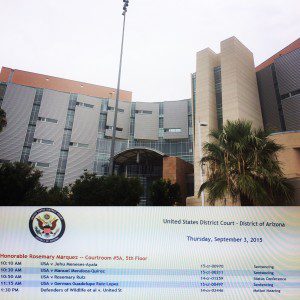
 The Patagonia Area Resource Alliance and Defenders of Wildlife were in federal court in Tucson last Thursday to present oral arguments against the Forest Service’s unlawful approval of a mining exploration project in the Patagonia Mountains on the Coronado National Forest.
The Patagonia Area Resource Alliance and Defenders of Wildlife were in federal court in Tucson last Thursday to present oral arguments against the Forest Service’s unlawful approval of a mining exploration project in the Patagonia Mountains on the Coronado National Forest.
Over 20 people attended the court hearing in support of PARA, Defenders of Wildlife and the Patagonia Mountains.
Canadian mining company Regal Resources’ Sunnyside Project involves drilling six exploratory holes for copper deposits up to 6,500 feet deep roughly five miles from the Town of Patagonia.
The Forest Service issued a “categorical exclusion” decision which essentially fast-tracked the mineral drilling exploration and approved the project without doing any environmental assessments. The decision authorized Regal Resources to run drilling for one year, with a seven month stoppage during the breeding seasons of the Mexican spotted owl and Yellow-billed cuckoo.
Defenders of Wildlife Lawyer Jay Tutchton argued that the Forest Service’s approval of the Sunnyside project violates environmental laws and poses a potential threat to local, endangered species. The extensive mineral drilling and construction would run 24 hours a day, seven days a week with total project operations and reclamation lasting up to 3 years.
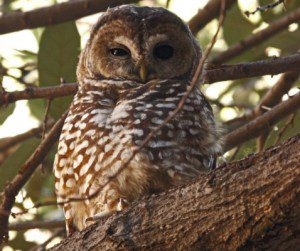
Mexican Spotted Owl ©Gooch Goodwin
The Patagonia Mountains support some of the world’s most threatened and endangered wildlife, including the jaguar, ocelot, lesser long-nosed bat, Mexican spotted owl, and yellow-billed cuckoo. Of particular concern is the Mexican spotted owl “Protected Activity Center” (PAC), prime habitat which is supposed to have the greatest protection by law and is occupied by the owls year-round. One of the project’s proposed drilling sites is less than 200 yards from a “nesting core area” of the PAC. The noise caused by the drills would be louder than a chainsaw and would disrupt about one-third of the Mexican spotted owls’ PAC, as well as the migratory corridors of jaguars and ocelots, Tutchton argued.
The Forest Service asked the court to dismiss the complaint. Forest Service lawyer Julia Thrower claimed the decision to grant a categorical exclusion complied with the National Environmental Protection Act and was not arbitrary or capricious.
“We’re optimistic that the judge will agree that the Forest Service’s attempt to avoid extra paperwork by skipping environmental assessments violates the law and places local, imperiled wildlife in even more jeopardy,” said Wendy Russell of the Patagonia Area Resource Alliance.
U.S. District Court Judge Rosemary Marquez said that she would take the matter under advisement and would issue her ruling before the proposed October 1 start date.

|
|
|
|
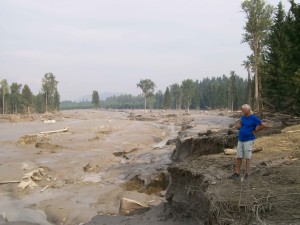
While Energy & Mines Ministers from across Canada are meeting in Halifax for their annual conference, a coalition of more than 50 environmental, First Nations, and community organizations today sent a letter to all Canadian Mines Ministers urging them to take immediate action to assess and prevent the threat posed by hundreds of mine waste dams and impoundments in Canada.
The groups are pressuring provincial and territorial governments in Canada to respond to the lessons learned from the August 2014 Mount Polley mine disaster in British-Columbia – the biggest mining waste spill in Canadian history.
In January 2015, the Independent Expert Review Panel on the Mount Polley failure determined that current Canadian and global standards for mine waste disposal are fundamentally flawed and that future failures at other mines are simply a matter of time.
The Expert Panel firmly rejected any notion “that business as usual can continue,” and urged the industry and all regulators to change the way mining waste facilities are designed, operated, and regulated in order to avoid any future failures: “The Panel does not accept the concept of a tolerable failure rate for tailings dams. To do so, no matter how small, would institutionalize failure. First Nations will not accept this, the public will not permit it, government will not allow it, and the mining industry will not survive it.”
In the wake of the Mount Polley disaster, the British Columbia government called for an investigation of the safety of all 123 tailings dams within the province, and recently appointed a Mining Code Review Committee to determine how best to implement the panel’s recommendations. No other governments in Canada have yet announced similar measures.

Hazeltine Creek following the spill (photo by Chris Blake).
The groups signing the letter released today urge all Canadian Mines Ministers to work together to support and implement all of the Mount Polley Independent Expert Review Panel’s recommendations in order to avoid any future massive mine waste spill in Canada (see all recommendations in letter). The groups also recommend additional scrutiny for mines upstream of the Canada-U.S. border that could present a risk to either country’s waters.
For further information and a complete list of the signatories, see letter: http://www.patagoniaalliance.org/wp-content/uploads/2015/07/2015-07-20_Mines_Ministers_Letter.pdf
ACTION BORÉALE – ALASKA TROLLERS ASSOCIATION – AMNESTY INTERNATIONAL CANADA – BC FIRST NATIONS ENERGY & MINING COUNCIL – BRITISH-COLUMBIA ENVIRONMENTAL NETWORK – CANADIAN ASSOCIATION OF PHYSICIANS FOR THE ENVIRONMENT – CANADIAN COALITION FOR NUCLEAR RESPONSIBILITY – CANADIAN PARKS & WILDERNESS SOCIETY – CENTER FOR ALTERNATIVE MINING DEVELOPMENT POLICY – CLAYOQUOT ACTION – COALITION FOR A CLEAN GREEN SASKATCHEWAN – COALITION POUR QUE LE QUÉBEC AIT MEILLEURE MINE – COMITÉ MINE DE RIEN DE ST-CAMILLE – COMITÉ POUR LES DROITS HUMAINS EN AMÉRIQUE LATINE – COMITÉ VIGILANCE DE MALARTIC – COMMITTEE FOR FUTURE GENERATIONS – COUNCIL FOR PUBLIC HEALTH IN MINING COMMUNITIES – COUNCIL OF CANADIANS – QUILL PLAINS CHAPTER – DAVID SUZUKI FOUNDATION – EARTHWORKS – ECOSYSTEM DEFENSE DIRECTOR – FAIR MINING COLLABORATIVE – FONDATION RIVIÈRES – FOREST PROTECTION ALLIES – FRASER RIVERKEEPER – FRIENDS OF THE CLEARWATER – FRIENDS OF THE EARTH CANADA – GRAND RIVERKEEPER LABRADOR – GROUPE DE THÉOLOGIE CONTEXTUELLE QUÉBÉCOISE – GROUPE SOLIDARITÉ JUSTICE – INTER-CHURCH URANIUM COMMITTEE EDUCATIONAL CO-OPERATIVE – JUST ONE WORLD – KAIROS – KIPAWA LAKE PRESERVATION SOCIETY – MARITIMES-GUATEMALA BREAKING THE SILENCE SOLIDARITY NETWORK – MINING INJUSTICE SOLIDARITY NETWORK – MININGWATCH CANADA – NORTHERN CONFLUENCE – NORTHWATCH – NUCLEAR INFORMATION AND RESOURCE SERVICE – OKANOGAN HIGHLANDS ALLIANCE – ONTARIANS FOR A JUST AND ACCOUNTABLE MINERAL STRATEGY – PATAGONIA AREA RESOURCE ALLIANCE – PEACE-NB – POLARIS INSTITUE – PRIMATE’S WORLD RELEASE AND DEVELOPMENT FUND – QUESNEL RIVER WATERSHED ALLIANCE – RAPIDE-BLANC PRODUCTIONS – REGROUPEMENT JUSTICE/ENVIRONNEMENT DES SŒURS DE SAINTE-CROIX – REGROUPEMENT POUR LA SAUVEGARDE DE LA GRANDE BAIE DE SEPT-ÎLES – RENEWABLE POWER INTELLIGENT CHOICE – RÉSEAU ŒCUMÉNIQUE JUSTICE ET PAIX – RIVERS WITHOUT BORDERS – ROCK CREEK ALLIANCE – SAVE OUR SKY BLUE WATERS – SCIENCE FOR PEACE – SEPT-ILES SANS URANIUM – SIERRA CLUB – SOCIÉTÉ POUR VAINCRE LA POLLUTION – SOUTHEAST ALASKA CONSERVATION COUNCIL – SQUAMISH ENVIRONMENT SOCIETY – UNION OF BC INDIAN CHIEFS – WATERSHED WATCH SALMON SOCIETY – WEBER SUSTAINABILITY CONSULTING.
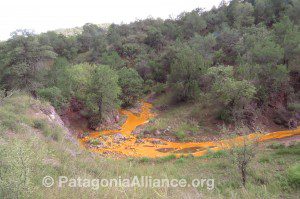

Toxic overflow from the historic Lead Queen mine in the Patagonia Mountains drains towards Harshaw Creek.
The Coronado National Forest, Sierra Vista Ranger District hosted a community meeting in Patagonia, Arizona on April 28. The Lead Queen Mine cleanup plan was by presented by Floyd Gray of United States Geological Survey (USGS), and Eli Curiel of the Forest Service.
The Lead Queen was an underground mine for lead, silver, zinc, copper and gold that started in 1898 and was abandoned after 1940. After heavy rains in September 2014, members of PARA discovered and reported the leaking mine site, located approximately 6 miles south of Patagonia, Arizona. In December, the Arizona Department of Environmental Quality served the Forest Service with two notices of violation for the toxic mine spill. The Forest Service issued a “Time Critical Removal Action Approval Memorandum” in February to mitigate the spill and its potential threats to public health and welfare, water and wildlife. Clean up was scheduled to start Spring 2015, before monsoon rains could potentially wash contamination further downstream.
Floyd Gray gave an overview of his findings from sampling and testing the water, soil, and waste rock around the abandoned mine site. It was also deduced that there is more than one source of leakage from the mine site. One source was identified by its extreme concentration of iron while the other source is high in aluminum. All of the tested samples came back with very high levels of contamination from hazardous heavy metals such as arsenic and lead. In one water sample, the heavy metal levels were 20 times higher than the allowable drinking water standards. It was also determined that the mine contamination traveled 9/10th of a mile downstream.
The studies at the Lead Queen site to determine all of the sources of contamination has lead to a larger, ongoing study of the watersheds in the Patagonia Mountains by USGS and the Forest Service.
Eli Curiel detailed the plans to plug the six abandoned tunnels and shafts of the Lead Queen mine site with polyurethane foam. The waste rock piles laced with toxic heavy metals will be consolidated into a new location above the watershed and capped with clean fill to prevent future contamination. The polluted sediment in the waterway will be removed with the aid of a series of eleven gabion walls across the drainage filled with zeolite to capture and hold the heavy metals. The clean up area comprises five acres on the Coronado National Forest in the Patagonia Mountains. The mine site will require ongoing monitoring and maintenance, essentially forever.
The cost to taxpayers has not yet been determined. The clean up project has not yet gone out to bid. It’s expected to take up to 120 days with work possibly starting this summer.
More information can be obtained from the Forest Service Project On-Scene Coordinator, Eli Curiel at 520-388-8413.

Mexican Spotted Owl ©Gooch Goodwin
At the public meeting, an update was given on Regal Resources’ Sunnyside mining exploration project in the Patagonia Mountains by Forest Service Geologist Mindy Vogel. Conspicuously absent from Vogel’s overview was the ongoing litigation between Defenders of Wildlife and PARA against the Forest Service and US Fish and Wildlife for the unlawful approval of this project.
For the present time, no work is allowed at the Sunnyside site between March 1 and Oct 1, 2015 because of nesting Mexican spotted owls and Yellow-billed cuckoos in the area, according to the Forest Service Decision Memo.
No questions were permitted during any of the presentations. Audience members were required to seek out Forest Service and USGS personnel after all presentations were complete to ask questions. It is a format that we find effectively prevents members of the community from getting all of their questions answered and learning the most information possible.
Forest Service geologist Margie DeRose gave an overview and an update of the expected timeline of the AZ Mining Inc (aka Wildcat Silver, AMI) Hermosa mining exploration proposal in the Patagonia Mountains on the Coronado National Forest. The final Environmental Assessment and draft decision is estimated for release in October 2015 – over a year past the original timeline. A 45 day public objection period will follow.
Meanwhile, AZ Mining Inc / Wildcat Silver board chairman Richard Warke is privately funding more mine exploration drilling on their privately owned land. AZ Mining Inc / Wildcat Silver is now claiming that deposits for lead, zinc and silver exist for an additional mine at the Hermosa project, referred to as Hermosa North West.

 The Forest Service sent out a notice on April 10th that a new Decision Memo has been issued for the Regal Resources Sunnyside project, an exploratory mineral drilling proposal in the Humboldt Canyon and Alum Gulch areas of the Patagonia Mountains on the Coronado National Forest.
The Forest Service sent out a notice on April 10th that a new Decision Memo has been issued for the Regal Resources Sunnyside project, an exploratory mineral drilling proposal in the Humboldt Canyon and Alum Gulch areas of the Patagonia Mountains on the Coronado National Forest.
The emailed notice from the Forest Service stated that exploratory drilling can start once “the operator provides a reclamation performance bond, incorporates the design features from the decision document, and the Plan of Operations is approved.”
The notice is misleading because it fails to mention two important facts.
No drilling can take place between March 1 to September 30 to avoid potential disturbance to the Mexican spotted owl and Yellow-billed cuckoo during their breeding season, as stated in the Decision Memo.
Additionally, PARA and Defenders of Wildlife are still in litigation against the Forest Service and US Fish and Wildlife Service for this unlawful approval of the Sunnyside Proposal. Read more…
The Sunnyside mineral drilling proposal is located approximately 7 miles south of the town of Patagonia. For more information concerning this decision, please contact Mindy Sue Vogel, Geologist, Coronado National Forest, 300 W. Congress Street, Tucson, AZ 85701, 520-388-8327, msvogel@fs.fed.us.

FOR IMMEDIATE RELEASE
TUCSON, ARIZ. — The Kevin Pakulis Band will play a benefit concert to raise funds and awareness for the Friends of the Mountain Empire on Saturday, May 9th at the Hotel Congress in Tucson. Tickets for the magical evening of music can be purchased now to support the organizations – Patagonia Area Resource Alliance, Sky Island Alliance, Defenders of Wildlife, Tucson Audubon Society, Center for Biological Diversity and Save the Scenic Santa Ritas – that are working to protect and preserve the habitat, water, and wildlife of the Mountain Empire from new mining in the Patagonia Mountains, Santa Rita Mountains, Canelo Hills, and the San Rafael Valley of southern Arizona.
The event will provide a unique and exciting opportunity to hear the soulful music of Tucson-based, award-winning Americana singer-songwriter Kevin Pakulis, while supporting the incredible ecological and cultural biodiversity of the region.
“Our goal is to draw attention to the local organizations that play a vital role in protecting and restoring wild places in southern Arizona. More specifically, to draw attention to the message they bring – a message that deserves careful consideration, if not enthusiastic action,” said Pakulis.

Ocelot, photo US FWS
Arizona’s southwestern Mountain Empire is a hidden gem of the country, recognized for its beauty, uniqueness and ecological importance. The region is rich in wildlife and plant diversity and supports some of the world’s most imperiled wildlife including the jaguar, ocelot, lesser long-nosed bat, Mexican spotted owl and yellow-billed cuckoo. Sadly, destructive mining projects that continue to be proposed and approved threaten not only endangered wildlife, but the water, health and safety of local communities.
The benefit will include a special guest appearance from Congressman Raúl Grijalva, who will speak to the importance of conserving the natural and local communities of the Mountain Empire in the face of such threats.
When: Saturday, May 9th, 7:00pm – 11:00pm
Where: Copper Hall in Hotel Congress, 311 E Congress St, Tucson, AZ 85701
Who: Kevin Pakulis Band, Friends of the Mountain Empire, Congressman Raúl Grijalva
Tickets: $20 Advance/$25 At the door
For more information and to purchase advance tickets, please visit: http://www.patagoniaalliance.org/friends-of-the-mountain-empire-benefit-concert-with-kevin-pakulis/

|
|
|||||||||||||||
|
|||||||||||||||
|
|||||||||||||||
|
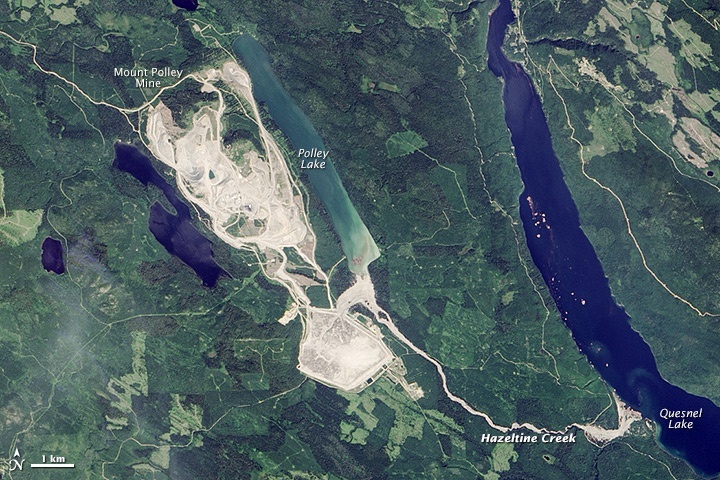
EARTHWORKS PRESS RELEASE
A coalition of more than 40 environmental and community groups today sent letters to the U.S.Environmental Protection Agency (EPA), Bureau of Land Management (BLM), and U.S. Forest Service (USFS) urging they take immediate action to investigate threats posed by mine waste dams and impoundments in the United States.
In the wake of the August 2014 Mount Polley mine waste disaster in Canada which released roughly 24.4 million cubic meters of mine waste into the Fraser River watershed, a government-commissioned independent investigative panel determined that current global standard practice for mine waste disposal is fundamentally flawed and that future failures at other mines are simply a matter of time. To date, U.S. regulators have taken no action to assess the risks posed by mines in the U.S.

Aerial view of the earthen dam at Mount Polley Mine in British Columbia that breached on August 4, 2014, sending contaminated water into nearby lakes.
“The most important finding of the Mount Polley investigation is that catastrophic mine waste dam failures can and will happen anywhere, unless we apply the lessons of Mount Polley and act to prevent them,” said Dr. David Chambers, president of the Center for Science in Public Participation. He continued, “Preventing these failures is critical to protecting the public from environmental and financial impacts, since there is no financial surety for catastrophic tailings dam accidents.”
“The best available science now warns that business as usual at modern mines means more mine waste catastrophes. That’s unacceptable,” said Jennifer Krill, Executive Director of Earthworks. “To protect clean water, communities and the environment, we need regulators in the United States to act on the lessons learned from the Mount Polley disaster.”
The government-commissioned, independent investigation into the Mount Polley dam failure concluded that the dam design was at fault, and predicted that an estimated 2 additional tailings dam failures could occur every 10 years in British Columbia if business continues as usual.
There are 839 tailings dams in the United States according the U.S Army Corps of Engineers. Mining companies worldwide use Knight-Piésold, the engineering firm that designed and built the tailings dam that failed at Mount Polley — including at the proposed Pebble copper-gold mine in the watershed of Alaska’s Bristol Bay.
Large tailings dams built to contain mining waste, among the largest structures in the world, must stand in perpetuity. Yet there is no federal agency in the U.S., nor global entity, responsible for oversight of tailings dam safety. The few tailings dam safety and construction requirements that exist were developed from those intended for water retention dams, not for mine tailings dams.
Farther south, the Mount Polley disaster has spurred worries about a proposed silver mine on U.S. Forest Service land only about 7 miles upstream of the tourist town of Patagonia, Arizona.
“Our town’s entire water supply is from groundwater, and the tailings dam would feed into the creek running through the town,” Coordinator Wendy Russell of the Patagonia Area Resource Alliance. “We already have acid leaks from historical mines,” she said. “We don’t need a Mount Polley here.”
FOR MORE INFORMATION
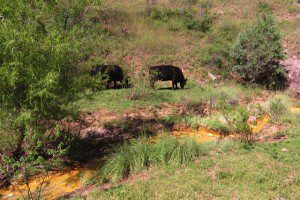
FOR IMMEDIATE RELEASE
Patagonia, Arizona – Yesterday, the Southwestern Regional Office of the US Forest Service issued an Action Memo for “Time Critical” clean up of the abandoned Lead Queen mine in the Patagonia Mountains on the Coronado National Forest, approximately 6 miles south of the town of Patagonia, Arizona.
Members of the Patagonia Area Resource Alliance (PARA) discovered the abandoned mine over-flowing with toxic, orange sludge into a tributary of Harshaw Creek, last September. PARA documented the spill and notified authorities. The Harshaw Creek tributary eventually flows into the Town of Patagonia, Sonoita Creek and Patagonia Lake.
As the land owners of the Lead Queen mine, the Forest Service was issued two Notice of Violations from the Arizona Department of Environmental Quality: “Addition of a pollutant to navigable waters from a point source without a permit,” and “Discharge of storm water associated with an industrial activity without a permit.”
 Test results showed off-the-chart concentrations of lead and arsenic in water, soil and waste rock samples at the Lead Queen site. High concentrations of zinc, copper and aluminum were also found. All of these heavy metals are listed as “hazardous substances” and can cause serious – or even deadly – health issues. The red-orange color of the sludge was due to extreme concentrations of iron.
Test results showed off-the-chart concentrations of lead and arsenic in water, soil and waste rock samples at the Lead Queen site. High concentrations of zinc, copper and aluminum were also found. All of these heavy metals are listed as “hazardous substances” and can cause serious – or even deadly – health issues. The red-orange color of the sludge was due to extreme concentrations of iron.
The USFS document stated the clean up aims to reduce potential exposure of the hazardous heavy metals to “human populations, animals or the food chain.”
“This is a good start, but I’ve seen many more abandoned mines in the Patagonia Mountains that also need to be cleaned up. The mining industry has a well-earned reputation for just walking away from mines when they’re done.” Gooch Goodwin, native Patagonian and PARA board member.
 The Forest Service document also acknowledges that the “Patagonia Mountains have high levels of biodiversity and are home to a variety of species protected under the Endangered Species Act including jaguar, ocelot, lesser long-nosed bat, Mexican spotted owl, western yellow-billed cuckoo, Sonora tiger salamander, and the northern Mexican gartersnake.”
The Forest Service document also acknowledges that the “Patagonia Mountains have high levels of biodiversity and are home to a variety of species protected under the Endangered Species Act including jaguar, ocelot, lesser long-nosed bat, Mexican spotted owl, western yellow-billed cuckoo, Sonora tiger salamander, and the northern Mexican gartersnake.”
It additionally states, “the area is best-known and most popular places for birding in the U.S. Bird enthusiast who come from all over the world to catch a glimpse of more than 300 species of birds, including many Neotropical species that migrate, nest, and live in this unique habitat.”
Clean up of the five acre site is expected to start Spring 2015 and be completed before the coming monsoon season to avoid erosion and flushing of heavy metals further downstream.
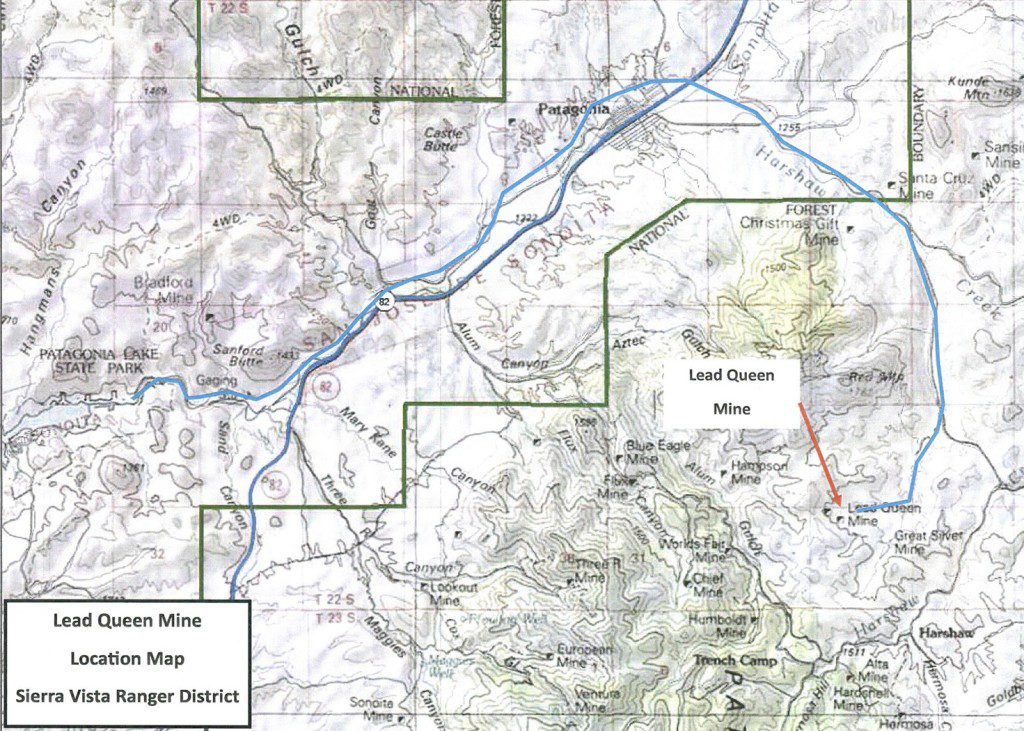
USFS map of Lead Queen mine location
Read USFS Lead Queen Mine Removal Action Memorandum
For further information regarding the USFS Removal Action Memorandum, please contact Eli Curiel, P.E., On-Scene Coordinator, at 520-388-8413; or Maria McGaha, P.E., Regional Environmental Engineer, at 505-842-3837.
###
The Patagonia Area Resource Alliance is a citizen watchdog organization that monitors the activities of mining companies, as well as ensures government agencies’ due diligence, to make sure their actions have long-term, sustainable benefits to our public lands, our water, and the town of Patagonia. For more information visit www.patagoniaalliance.org and follow us on Twitter @PARAalliance.

FOR IMMEDIATE RELEASE
Tucson, Ariz. — Today the U.S. Forest Service temporarily put the brakes on an environmentally hazardous mining project in southern Arizona’s Coronado National Forest that it previously approved in August. The Forest Service’s decision follows a similar move by the U.S. Fish and Wildlife Service, which had originally given the project the green light in August and then withdrew its approval in December. The agency decisions to withdraw their approvals of the Canadian mining company Regal Resources’ “Sunnyside Project” are based on the project’s potential violation of multiple environmental laws.

photo by Nathan Rupert
“The agencies knew from the beginning that this project could have a devastating impact on the local wildlife and habitat in this unique corner of the country,” said Rob Peters of Defenders of Wildlife. “The Coronado is home to an incredible diversity of imperiled species like the jaguar, ocelot and yellow-billed cuckoo, all which are already at risk from multiple projects in the region.”
“No one understood why they approved this project to begin with, but for the sake of Patagonia’s residents and wildlife, we are glad to see that they’ve reconsidered,” added Peters.
In October conservation groups Defenders of Wildlife and the Patagonia Area Resource Alliance filed a lawsuit claiming the federal agencies’ approvals the Sunnyside project violated environmental laws and posed a threat to endangered species and the safety of drinking water for local residents.
“Sunnyside could have been a disaster not only for our region’s unique wildlife, but also for the residents living directly downstream and the municipal watershed of the town of Patagonia,” said Wendy Russell of the Patagonia Area Resource Alliance. “Projects like Sunnyside use and abuse a tremendous amount of the local water supply and create long-term destruction of wildlife habitat. The people and wildlife of our national forests deserve more, and the agencies know that.”
Click to hear from environmental attorneys on why they sue.
###
Contact: Courtney Sexton, csexton@defenders.org, 202-772-0253
Wendy Russell, wendy@patagoniaalliance.org, 520-477-2308
Defenders of Wildlife is dedicated to the protection of all native animals and plants in their natural communities. With more than 1.1 million members and activists, Defenders of Wildlife is a leading advocate for innovative solutions to safeguard our wildlife heritage for generations to come. For more information, visit www.defenders.org and follow us on Twitter @DefendersNews.
The Patagonia Area Resource Alliance is a citizen watchdog organization that monitors the activities of mining companies, as well as ensures government agencies’ due diligence, to make sure their actions have long-term, sustainable benefits to our public lands, our water, and the town of Patagonia. For more information visit www.patagoniaalliance.org and follow us on Twitter @PARAalliance.
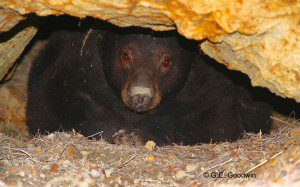
The AZ Mining Inc (Wildcat Silver) Hermosa drilling project timeline was just pushed back–now almost a full year behind the previous schedule. We couldn’t have planned a better holiday gift! The release of the Hermosa Environmental Assessment (EA) and Draft Decision is now estimated for July 2015, which would then trigger a 45 day deadline for objections. If you commented on the Hermosa project, you will be able to participate in the objection process. PARA has successfully delayed AZ Mining Inc / Wildcat Silver–and all other mining companies–from drilling on public land in the Patagonia Mountains since 2011.

Save my home in the Patagonia Mountains. ©Gooch Goodwin
Billie the Black Bear makes her home in the Patagonia Mountains. Open pit mining would destroy her home and the water that we all depend upon. Your gift to the Patagonia Area Resource Alliance empowers us to keep new mining activity off of public land in the Patagonia Mountains–successfully since 2011!
Read more about our most recent Activities and Accomplishments.
Your donations also make it possible for us to organize community involvement and action so that we can protect the Patagonia Mountains, wildlife and habitats, our waterways and our communities.
Please consider making a donation to PARA this year to support and grow this critical work in the Patagonia Mountains: patagoniaalliance.org/donations/
A big thank you to everyone who has already donated this year!
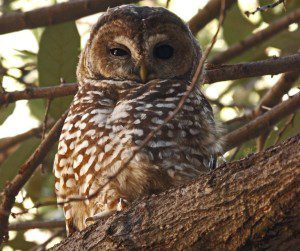
Mexican Spotted Owl © Glen E Goodwin
The Forest Service approved the Sunnyside mineral drilling proposal by Regal Resources in the Patagonia Mountains, even though it directly threatens the imperiled Mexican spotted owl in the most sensitive area of their habitat–their roosting and nesting areas. As a result, we filed suit in federal court with Defenders of Wildlife for that unlawful approval, which violates environmental laws and poses potential threats to additional endangered species and the safety of drinking water for local residents.
We are very fortunate to have a group of amazingly committed community members and generous donors supporting our work.
We’ve just exceeded our year-end goal of raising $19,000! We on our way to reaching our entire 2015 operating budget. Thank you!
The work necessary to keep mining out of the Patagonia Mountains a reality is only possible because of your financial support.
Consider making an automatic, monthly donation to PARA on your credit card through PayPal.
Every single contribution makes a sizable difference to our organization and ultimately for our community.
It is only because of the generous support from people like you that we can undertake this critical work. Thank you!

It’s hard to believe that the end of the year is nearly upon us! When 2014 began, your friends, neighbors and colleagues here at the Patagonia Area Resource Alliance (PARA) were gearing up for a busy year promoting the incredible beauty, community, and natural heritage of the Town of Patagonia and the Patagonia Mountains. Little did we know what a whirlwind year it would be! The past eleven months have seemingly sped by while we have been advocating to protect this amazing place that we all treasure from the multiple threats that exploratory drilling and mining pose to our small community.
PARA was formed in 2011 to educate and engage the community about the risks and realities of mining, to promote local sustainable economies, to better understand our precious and imperiled natural resources such as clean water and wildlife, and to actively advocate for the protection of those resources in concert with Patagonia’s distinct and serene rural way of life.
You have helped us along the way this year! You have volunteered, come to public meetings, wrote letters, monitored wildlife, and participated in the NEPA process. Together, we have contributed over 2500 volunteer hours already in 2014!
It has been another amazing and transforming year for PARA, but we have so much more to do! PARA runs on a shoestring budget with the human power of an almost entirely volunteer workforce and our two person outreach team–budgeted for only 30 hours per week. We’d like to do so much more! Please consider making a donation to PARA this year to support and grow this critical work in our community.
Filed a complaint in federal court in October with Defenders of Wildlife against the Forest Service and the Fish and Wildlife Service for their unlawful approval of the Regal Resources Sunnyside mineral drilling project in southern Arizona’s Coronado National Forest, in the Alum Gulch area of the Patagonia Mountains. The Sunnyside project approval violates environmental laws and poses a potential threat to endangered species and the safety of drinking water for Patagonia area residents. The Coronado National Forest, Patagonia Mountains and waterways in our region support some of the world’s most imperiled wildlife, including jaguar, ocelot, lesser long-nosed bat, Mexican spotted owl, and yellow-billed cuckoo.
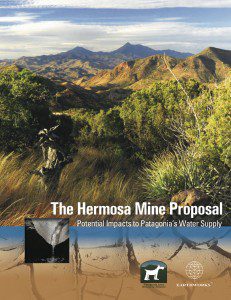 Educating the Community on Mining Risks
Educating the Community on Mining RisksReleased a peer-reviewed report with the national organization EARTHWORKS, “The Hermosa Mine: Potential Impacts to Patagonia’s Water Supply.” The report uses geologic and hydrologic studies from mine developer AZ Mining Inc (Wildcat Silver), the United States Geologic Survey, the Arizona Department of Water Resources, the Town of Patagonia, and others, as well as analyzes historic contamination issues caused by mining in the Patagonia Mountains. We conclude in our report that the seemingly inescapable realities of acid drainage and water consumption impacts pose too great a risk to Patagonia.
Coordinated and submitted NEPA comments on the USFS draft Environmental Assessment for the AZ Mining Inc (Wildcat Silver) Hermosa drilling project with Defenders of Wildlife, Arizona Mining Reform Coalition, Center for Biological Diversity, Earthworks, and Sky Island Alliance. Hosted a community workshop to empower residents to comment on the Hermosa EA comprising of an overview of the Hermosa proposal and its likely impacts; a NEPA presentation and how to comment on an EA by Jenny Neeley, Attorney at Law; and a presentation of area wildlife by Biologist, Sergio Avila, of Sky Island Alliance.

Sonoita Creek
Submitted comments regarding the proposed United States Forest Service Guidelines on Groundwater, advocating for groundwater protection and consideration of potential impacts regarding all agency activities in our National Forests, especially in regards to hardrock mining. Submitted comments to the Environmental Protection Agency regarding the proposed rule defining the “Waters of the U.S.” advocating for protection of ephemeral and intermittent streams. Submitted comments advocating for more designated critical habitat in the Patagonia Mountains for the threatened yellow-billed cuckoo.
To learn more about our 2014 accomplishments and efforts, please take a look at PARA’s “Report to the Community” available on our website at: www.patagoniaalliance.org/our-activities- outreach/
With continued legal assistance from Defenders of Wildlife, PARA strives to hold mining companies, the US Forest Service and all agencies accountable to follow the laws and regulations designed to protect our water, air, surrounding ecosystems and communities. We are positioned to respond to future exploratory mining proposals scheduled for the Patagonia Mountains.
Citizen scientists from the community continue wildlife monitoring efforts in the Patagonia Mountains focusing on areas immediately at risk by proposed mining activities. Data gathered is used to fight mining proposals through species lists, presence of vulnerable species and habitat analysis. Additional collaborations are ongoing with Defenders of Wildlife, EARTHWORKS, Sky Island Alliance and Tucson Audubon to ensure this data is applied to advocacy efforts in the most effective ways.
PARA is strategizing to expand community education activities to grow our base of support and empower concerned residents with potential actions to keep mining out of the Patagonia Mountains. We recognize the need to establish sustainable funding to maintain core functions and seek to expand funding sources. With our additional staff funding in the 2015 budget, we plan to sustain our two person team to continue to expand our outreach beyond our community boundaries. Our 2014 Financial Report is also available online: www.patagoniaalliance.org/our-activities-outreach/
PARA recognizes that the health and economic prosperity of our community are deeply connected to the well-being of the Patagonia Mountains and the Harshaw/Sonoita Creek watershed. They are the source of our drinking water, clean air and the centerpieces that drive our local economy.
There are many needs in our community and many compelling requests for support. We believe one of the most fundamental is protecting our drinking water and our community from the well-known detrimental effects of open pit mining. To that end, PARA is seeking to raise $19,000 by the end of 2014 to support the several ongoing and new initiatives outlined above as we move into 2015. We are fortunate to have a group of amazingly committed community members and generous donors supporting our work, but we are looking to broaden the base of support to ensure not only financial sustainability, but also the ability to impact local, regional and national decision-making on our own behalf.
That’s where you come in. The work necessary to make this vision of 2015 a reality is possible only because of your time and your financial support. Please make a gift today.
Recurring monthly donations can be made securely through PayPal.
Every single contribution makes a sizable difference to our organization and ultimately for our community. It is only because of the generous support from people like you that we can undertake this critical work. Thank you!

FOR IMMEDIATE RELEASE
October 29, 2014
Contact: Courtney Sexton, csexton@defenders.org, 202-772-0253
Wendy Russell, wendy@patagoniaalliance.org, 520-477-2308
TUCSON, ARIZ. – Defenders of Wildlife and the Patagonia Area Resource Alliance today asked a federal court to hold the United States Forest Service and United States Fish and Wildlife Service accountable for their unlawful approval of the “Sunnyside” mineral exploration drilling project in southern Arizona’s Coronado National Forest, in the Alum Gulch area of the Patagonia Mountains. The groups say the approval of the Canadian mining company Regal Resources’ Sunnyside Project violates environmental laws and poses a potential threat to endangered species and the safety of drinking water for local residents. The Sunnyside Project involves drilling multiple exploratory holes up to 6,500 feet deep in one of the most biologically diverse mountain ranges in Arizona. The extensive drilling and construction would run 24/7 for months on end, and the total project operations could last up to 3 years.
The Coronado National Forest, the Patagonia Mountains and the watersheds in this region support some of the world’s most imperiled wildlife, including the jaguar, ocelot, lesser long-nosed bat, Mexican spotted owl, and yellow-billed cuckoo. Of particular concern is the Mexican spotted owl “Protected Activity Center” (PAC) in the Alum Gulch area, a site which is supposed to have the greatest protection of the law. One of the project’s proposed drilling sites is only one-tenth of a mile from the “nesting core area” of this PAC.
“The potential damage from the Sunnyside Project, especially coupled with other damaging mining projects in the region, could have devastating impacts on this imperiled wildlife and the habitat they depend on, as well as the water supply for local residents,” said Rob Peters of Defenders of Wildlife. “This is a national forest and imperiled wildlife and their habitats on the forest should be protected— not polluted by expanded drilling operations.”

Ocelot, Leopardus pardalis. photo US FWS
Patagonia area residents are dependent on water originating from Alum Gulch, an area which is also designated as critical habitat for the jaguar and Mexican spotted owl. The imperiled ocelot, lesser long-nosed bat, and yellow-billed cuckoo have also been observed near the project area.
“The Sunnyside Project could have tremendous adverse impacts on local wildlife and local residents, affecting the floodplains and the municipal watershed of the town of Patagonia,” said Wendy Russell of the Patagonia Area Resource Alliance. “The drilling will require 12,500 gallons of water per day, an amount approximately equal to ten percent of the daily water usage of the Town of Patagonia. This project threatens not only endangered wildlife, but our community’s water, health and safety.”
Click to hear from environmental attorneys on why they sue.
###
Defenders of Wildlife is dedicated to the protection of all native animals and plants in their natural communities. With more than 1.1 million members and activists, Defenders of Wildlife is a leading advocate for innovative solutions to safeguard our wildlife heritage for generations to come. For more information, visit www.defenders.org and follow us on Twitter @DefendersNews.
The Patagonia Area Resource Alliance is a citizen watchdog organization that monitors the activities of mining companies, as well as ensures government agencies’ due diligence, to make sure their actions have long-term, sustainable benefits to our public lands, our water, and the town of Patagonia. For more information visit www.patagoniaalliance.org and follow us on Twitter @PARAalliance.
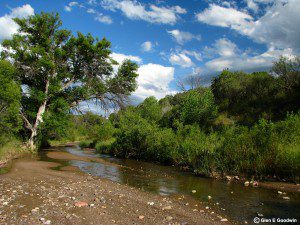
Patagonia Area Resource Alliance
Earthworks
October 28, 2014
 Patagonia – The Hermosa silver mine proposed inside Patagonia, Arizona’s Municipal Supply Watershed could deplete the town’s drinking water and perpetually contaminate area groundwater with acid mine drainage, according to a new peer-reviewed report.
Patagonia – The Hermosa silver mine proposed inside Patagonia, Arizona’s Municipal Supply Watershed could deplete the town’s drinking water and perpetually contaminate area groundwater with acid mine drainage, according to a new peer-reviewed report.
Reviewed* by a USGS scientist and released by the Patagonia Area Resource Alliance and Earthworks, the study also concludes that drinking water wells of surrounding residents are also threatened.
“A mine that threatens our town’s drinking water is a mine that shouldn’t be built,” said Wendy Russell of the Patagonia Area Resource Alliance. She continued, “In Arizona, water is more precious than silver, and especially so after more than a decade of drought.”
Proposed by Canadian exploration company AZ Mining Inc (Wildcat Silver) – a company with no experience operating a mine – Hermosa is proposed at a time when Patagonia is already concerned with dropping groundwater levels and increasing concern about future water supplies.
The 4,000 foot wide and 1,500 foot deep Hermosa silver and manganese mine would consume 670 million to 1.2 billion  gallons of groundwater per year – up to 53 times the amount of water the town uses today — to run the mine within the upper reaches of Harshaw Creek, a portion of Patagonia’s Municipal Supply Watershed. This water consumption will lower the recharge rates for the aquifer on which the town depends, and is also likely to produce acidic runoff, requiring ongoing treatment in perpetuity.
gallons of groundwater per year – up to 53 times the amount of water the town uses today — to run the mine within the upper reaches of Harshaw Creek, a portion of Patagonia’s Municipal Supply Watershed. This water consumption will lower the recharge rates for the aquifer on which the town depends, and is also likely to produce acidic runoff, requiring ongoing treatment in perpetuity.
“If the U.S. Forest Service were to permit the Hermosa mine, this report shows it would jeopardize our community’s drinking water. And for what? For foreign shareholders’ silver,” said Wendy Russell. She continued, “This is a mine proposal that just doesn’t make sense for our community who would actually have to live with it.”
The mine is proposed within the Coronado National Forest, and therefore subject to the 1872 Mining Law. Federal land managers interpret the 1872 Mining Law to require them to permit mines, no matter if the land is better used for other purposes – like protecting a town’s drinking water supply watershed.
“Because the Hermosa mine proposal threatens area water supplies, it obviously should not be permitted,” said report author Pete Dronkers of Earthworks. He continued, “That it’s being considered at all is a strong argument for reforming the 1872 Mining Law to allow the consideration of other potential land uses.”
The report also evaluates the nature of groundwater depletion that is likely under the proposed mine plan, characterizes the impacts of such, and also analyses other known adverse impacts, such as air pollution, endangered species, and other cumulative impacts.
The report, including an executive summary, can be found at: patagoniaalliance.org/report-hermosa-mine
Fact Sheet
Full Report
Contact:
Pete Dronkers, Earthworks
(775) 815-9936, pdronkers@earthworksaction.org
Wendy Russell, Patagonia Area Resource Alliance
(520) 477-2308, wendy@patagoniaalliance.org
* An earlier version of this press release indicated that a USGS scientist “endorsed” this report. We were informed by the United States Geological Survey that the agency only endorses their own reports and documents.
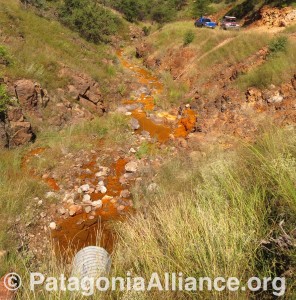
FOR IMMEDIATE RELEASE
Contact: Courtney Sexton, 202.772.0253, csexton@defenders.org
Wendy Russell, 520.477.2308, Wendy@PatagoniaAlliance.org

Bright orange water overflowing from the historic Trench mine, twice reclaimed by Asarco and now owned by the State of Arizona.
TUCSON, ARIZ. – Contaminants from a mine spill in Cananea, Sonora earlier this summer have likely reached the San Pedro River flowing into Arizona. And with recent storms, old copper and silver mine sites near Patagonia are leaking bright red contaminants into local streams. These toxic reminders of our mining history have the potential to wreak havoc on local water supplies and wildlife in the Coronado National Forest, one of the most biologically diverse areas in the world.
“The Coronado National Forest, the “Sacred” Santa Ritas, the San Pedro River Valley, the Patagonias and all of the Sky Islands nourish some of the most incredible and endangered biodiversity in the world, including jaguars, ocelots, yellow-billed cuckoos and Gila topminnows,” said Eva Sargent, director of Southwest Programs for Defenders of Wildlife. “This is a place that must be conserved, not a place for the destructive practice of mining and its toxic byproducts that ruin our public landscapes and pollute our waters.”

Toxic overflow from the historic Lead Queen mine in the Patagonia Mountains drains towards Harshaw Creek.
“All this toxic runoff is a prime example of why new mines should not be approved in the mountains of southern Arizona,” added Wendy Russell of the Patagonia Area Resource Alliance. “There are already approximately 130 abandoned mines in the Patagonia Mountains, many with eroding tailings and leaking tunnels discharging toxins. With heavy rainfall, that toxic discharge overflows into water systems like Harshaw Creek and Alum Gulch in the Santa Cruz watershed and threatens both local communities’ drinking water and already endangered fish and wildlife. With the state and federal governments seemingly incapable of cleaning up old polluting mines in the Patagonia Mountains, we have no confidence in their abilities to regulate new mining activity to protect our community’s drinking water, health and safety.”
###
Defenders of Wildlife is dedicated to the protection of all native animals and plants in their natural communities. With more than 1.1 million members and activists, Defenders of Wildlife is a leading advocate for innovative solutions to safeguard our wildlife heritage for generations to come. For more information, visit www.defenders.org<http://www.defenders.org/> and follow us on Twitter @DefendersNews<http://twitter.com/DefendersNews>.
The Patagonia Area Resource Alliance is a citizen watchdog organization that monitors the activities of mining companies, as well as ensures government agencies’ due diligence, to make sure their actions have long-term, sustainable benefits to our public lands, our water, and the town of Patagonia. For more information visit www.patagoniaalliance.org<http://www.patagoniaalliance.org>
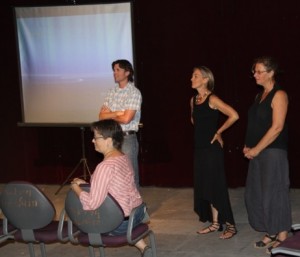

Filmmaker Ben Johnson, Director Kimi Eisele and Composer Vicki Brown fielding questions.
The Patagonia Area Resource Alliance hosted a reception and screening of ‘Rosemont Ours’ in Patagonia on Saturday, May 17. The evening began with a reception at Molly’s Studio Patio followed by a screening of “Rosemont Ours,” a film of modern dance celebrating the plants and animals of the Santa Rita Mountains. Filmmaker Ben Johnson, Director Kimi Eisele and Composer Vicki Brown were on hand to introduce the film and answer questions. “Rosemont Ours” was born in response to the proposed construction of the Rosemont Mine. By “replacing” plants and animals with human beings in reverential and playful ways, the film invited us to consider our role as both stewards and consumers of nature. “Rosemont Ours” can be viewed online: http://rosemontours.com/the-video/
PARA board member, Carolyn Shafer also spoke to the audience providing an update to PARA’s activities, introducing the PARA board and thanking the community for their ongoing support. These are her words:
 The real wealth of a community is measured by its inhabitants – human, plant and animal. Our community is very wealthy. Our abundance is the water and air and land that has supported life in this region for many thousands of years. We all need to be involved in protecting our natural resources from further degradation and to regenerate our region’s habitat to better support our biodiversity. And that is the essence of Patagonia Area Resource Alliance’s mission statement.
The real wealth of a community is measured by its inhabitants – human, plant and animal. Our community is very wealthy. Our abundance is the water and air and land that has supported life in this region for many thousands of years. We all need to be involved in protecting our natural resources from further degradation and to regenerate our region’s habitat to better support our biodiversity. And that is the essence of Patagonia Area Resource Alliance’s mission statement.
Many of you here tonight help in this cause through your financial support which is deeply appreciated – some day we won’t have to ask for ongoing support but that day has not yet arrived. Some of us are able to give our time to this work and I’d like to introduce you to our Board and staff: Michael Stabile, Gooch Goodwin, Joe Nitche and not able to be here tonight: Cliff Hirsch, Kati Ballard, Lee Rogers. Our staff: Coordinator Wendy Russell and Social Media Outreach Colin Treiber.
In addition to help fund these efforts, writing comments is also appreciated including those recently submitted on the Wildcat Silver Hermosa drilling proposal. The next step will be the release by the Forest Service of the Final Environmental Assessment and the Draft Decision expected to be made public in June or July. That will open a 45 day Objection Period. If you commented on the Hermosa drilling proposal during a public comment period, you are eligible to participate in the objection process.
PARA is strategically creating alliances with other organizations. It is a gratifying experience to introduce representatives from these organizations to our corner of the cosmos. It is not an understatement to say that they fall in love with our area and value its unique biodiversity and want to assist in protecting the Patagonia Mountains.
-PARA coordinated a Coalition of International, Regional and Local Organizations to comment on the Forest Service Draft Environmental Assessment for the Hermosa drilling proposal. Those organizations are the Arizona Mining Reform Coalition, Center for Biological Diversity, Defenders of Wildlife, Earthworks, and Sky Island Alliance.
-We hosted the Defenders of Wildlife Southwest Office and legal team for a 2 day tour of proposed mine sites in the Patagonia Mountains.

WMAN conference participants from L: Roy Chavez, Concerned Citizens and Retire Miners Coalition; Wendy Russell, PARA; Aaron Mintzes, Earthworks; Lauren Pagel, Earthworks; and Roger Featherstone, AZ Mining Reform Coalition.
-Through a generous scholarship program, PARA Coordinator Wendy Russell attended the Western Mining Action Network (WMAN) conference on May 9-10, 2014 in Anchorage, Alaska. WMAN provides a critical forum for communities facing mining in the United States and Canada. Their conference provides an excellent venue for information sharing, networking, learning, and strategizing among organizations and individuals working to reduce the negative environmental and social impacts of mining.
-PARA has teamed with Earthworks to develop an independent, peer-reviewed study of the potential impacts of Wildcat Silver’s open pit mine on our groundwater, the potential for acid drainage contamination, heavy metals pollution, as well as the range of issues associated with air pollution, light and noise pollution.
Why do any of us give our time and our money for this cause? I think a quote from scientist David Suzuki summarizes the core motivation for each of us: “There are some things in the world we can’t change–gravity, entropy, the speed of light, and our biological nature that requires clean air, clean water, clean soil, clean energy and biodiversity for our health and well being. Protecting the biosphere should be our highest priority or else we sicken and die.”
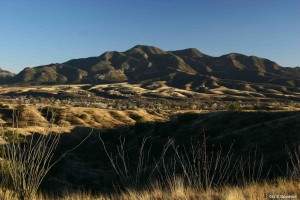
By Carolyn Shafer
It is critical that we as individuals, our governing bodies and our community organizations mindfully support existing businesses and invite new business activity that will create a stable and sustainable economy and provide livelihood to all who are willing to work. Let’s first consider some historical and economic information.
The longest lasting local economic activity in the Patagonia area during the last four centuries has been ranching, a part of the economy even now. As prospecting in the 19th and 20th centuries found major mineral deposits, there has also been two boom-and-bust periods of mining, from about 1860-1910 and again in the middle 20th century. The last mine near Patagonia closed in 1965.
 In the 50 years since the last mining bust, the community has rebuilt its local economy based on ranching, tourism, local food production and recreational amenities (birding, hunting, camping, cycling, hiking, etc).
In the 50 years since the last mining bust, the community has rebuilt its local economy based on ranching, tourism, local food production and recreational amenities (birding, hunting, camping, cycling, hiking, etc).
How did the local economy perform under the industrial based economy (predominantly mining) and under the service based economy (predominantly tourism)? A review of all available Town of Patagonia financial audits (1963-2013) helps quantify a half century of economic transformation for the Town of Patagonia. Sales tax revenue is one measurement of the town’s financial health. In 1963, the Town’s sales tax revenues in comparable 2013 dollar value was $54,311 (actual revenue was $7,191). In 2013, the Town’s sales tax revenue was $197,540. The service based economy (predominantly tourism) in 2013 provided 364% more sales tax revenue than the predominantly mining industrial based economy. Another measure of the town’s health is population, the town’s population grew from 540 in 1960 to 913 in 2013 – a growth of 69% under the service based economy.
I am one of the owners of the local artists gallery. Our business represents more than 40 area artists. 85% of our business is from visitors to the Patagonia Mountains who come here to enjoy birding, hunting, camping, cycling, hiking and other outdoor recreational activities. I believe that my business and almost all of the existing businesses will be destroyed as the result of new mining in our mountains. The existing, local jobs that will be lost will exceed any mining jobs that might be created for local people. Yes, there is a history of mining in this area. I know that there are families in our community who were part of that mining tradition. Historic mining put food on the table and provided a living for many local families. Those historic mines and jobs are of an entirely different time and place than would exist with today’s mining practices.
What can we as a community do now to proactively create a stable local economy? I propose that we create a discussion group that includes all businesses as well as community organizations and interested individuals. A few of the topics include a look at the factual information available about the current employment situation, the history of this area’s economic stability and success under both the industrial and the service based economies, discussions about how we can support our existing businesses, and determine how we attract new businesses that will contribute to this thriving, resilient community. I hope to enlist local business owners and community organizations to participate in such a discussion so that we can work together as a community to establish a plan that truly perpetuates a strong and sustainable economy. I will first reach out to the Patagonia Area Business Association and the newly formed Patagonia Regional Business Coalition as two organizations that represent various business interests in the community.
Please share your suggestions for economic development and local employment. My contact information is in the Country Connection.